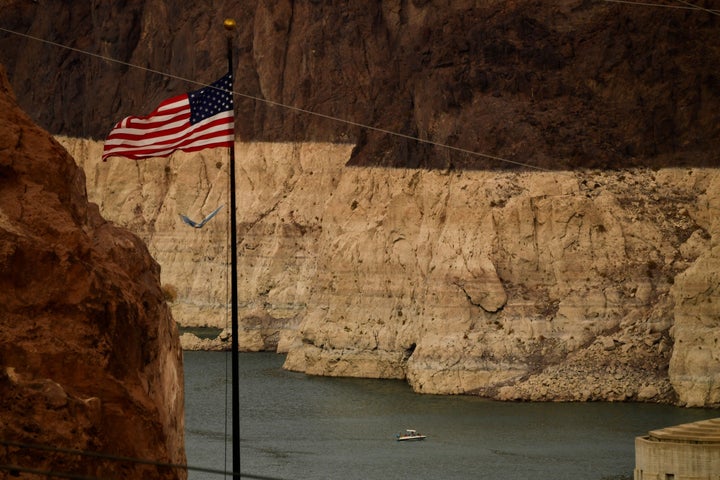Western States Face First Colorado River Water Cuts As Megadrought Drains Reservoirs
Arizona, Nevada and two Mexican states that rely on the Colorado River for drinking water and irrigation will face cuts to their supply next year as a prolonged megadrought parches the American West, leaves reservoirs depleted and casts doubt over the future of vital freshwater reserves as climate change worsens.
On Monday, the federal Bureau of Reclamation declared a water shortage at Lake Mead as water levels fell below the 1,075-foot threshold that triggers mandatory reductions in the amount of water the nation’s largest reservoir dispenses to millions in the lower Colorado River Basin.
The cutbacks mark the first time in Lake Mead’s 86-year history that demand for water has eclipsed what federal authorities can safely supply, even in a system where reservoirs store four times more water than what flows annually down the river. The tier-one shortage — the worst designation, based on the lake’s record-low water levels — paints a troubling picture of the hardships to come as the Southwest’s growing population competes for dwindling resources while temperatures rise and precipitation falls due to soaring fossil fuel emissions. The region’s stored water capacity dropped to 40% last month, down from 49% a year earlier.
The shortage is a sign that the reservoir’s “bathtub ring” — the area of previously submerged rock that appears white due to mineral deposits — will remain to mark a high-water era unlikely to return.
Three U.S. states share the river’s lower basin, but California will avoid cutbacks next year thanks to legal rights dating back more than a century that privilege the most populous state in the nation’s claim to Colorado River water. Farmers in Arizona and Nevada, as well as in Mexico’s Baja California and Sonora states, will face shortages starting in 2022.
“The Colorado River is absolutely in crisis with this 20-year drought persisting, but we’ve gotten through it and effectively mitigated it so far by relying on reservoir storage,” said Jennifer Pitt, the Colorado River program director at the National Audubon Society. “We’ve been sipping our way through this to get through this, but as reservoirs drop and drop and drop, that’s not sustainable.”
Cities in the affected area, including Phoenix and Tucson, won’t see any major changes, meaning it’s mostly agricultural communities that eke alfalfa, corn and other crops out of the red desert that will be forced to do more with less.
The shortage in Nevada will affect the smallest area by far.
The Colorado River Indian Tribes ― a federally recognized confederation of Mohave, Chemehuevi, Hopi and Navajo people ― volunteered to stop farming crops in the Arizona portion of their reservation to eliminate water use in exchange for payments from the state. Mostly white farmers across Pinal County, by contrast, are expected to receive some additional drilled water and reservoir water next year to make up for lost Colorado River water.
Unlike in the United States, where the laws governing water rights date back to 19th-century mining claims that give older stakes first dibs, Mexico has no system of seniority and will implement 5% supply cuts across the board to irrigators in the Mexicali Valley.
While the cuts will reduce risk of further shortages, Bureau of Reclamation Deputy Commissioner Camille Touton said “we have not eliminated the potential for continued decline of these critically important reservoirs” and warned that “additional actions will likely be necessary in the very near future.”
“At the turn of the millennium, our major reservoirs in the basin ― Lake Mead, and Lake Powell ― were nearly full. I remember being on a tour at Hoover Dam and standing at the top of the dam, leaning over and thinking I could touch the water because the water level was so high,” Touton said, noting her hometown was in the river basin. “Little did we know then that 2000 would be the start of what is now a 22-year drought.”
Two months ago, the Bureau of Reclamation cut off water to farmers and tribes in a lush but increasingly dry valley on the border between California and Oregon. The decision stoked tensions between the mostly white farmers and Indigenous tribes, who lobbied for reductions in water distributed for irrigation in hopes of preserving water levels for endangered fish.
In response to the federal cutbacks, farmers joined anti-government groups and threatened violence unless authorities restored water deliveries. To some, the incident amounted to “a new water war,” while others warned of “another Dust Bowl” looming, a repeat of the poverty and mass migration triggered by crop failures in the 1930s.
Water rationing has become far more routine, and has gone far less remarked upon, in the more peripheral places where the U.S. flag flies. Native Americans, particularly those on reservations in the Southwest, comprise a huge portion of the 2 million people in the U.S. who still don’t have running water, making the country’s Indigenous minority 19 times more likely to lack indoor plumbing than members of the white majority, according to a 2019 report from the U.S. Water Alliance.
In Puerto Rico, the largest remaining U.S. territorial possession, residents have routinely faced months of water rationing in recent years, with ratepayers going up to two days a week without being able to use their sinks, toilets or showers. As in the U.S. mainland, the shortages are largely driven by droughts, agribusiness giants that use as much water as they want, leaking pipes and saltwater intrusion as rising seas penetrate underground aquifers.
The Senate’s recently passed bipartisan infrastructure deal includes billions in funding for water infrastructure, especially to tribes, and the restoration of forests and wetlands deemed crucial to natural water tables. Experts say those investments are a good start but are long overdue as problems from droughts compound.
Among the consequences that could add up next year are water shortages bringing more hydroelectric dams across the West to a halt. To boot, most drought models consider the effect of reduced snowmelt in the mountains that feed the Colorado River. However, scientists also fear that temperatures could get so hot that the water evaporates, significantly amplifying droughts.
“The biggest message we take from this is that the Colorado River Basin is ground zero for climate change in the U.S.,” said Kevin Moran, the senior director of the Environmental Defense Fund’s Colorado River program. “This should be a blaring wake-up call.”
RELATED…
Source: Read Full Article


